As a small local business, competing against larger corporations can be daunting. However, by leveraging local business strategies and effective small business marketing techniques, you can carve out your niche and attract loyal customers.

Small businesses have unique advantages, such as personalized service and community involvement, which can help them stand out. This article will explore practical tips and strategies to help your small business thrive in a competitive market.
Table of Contents
Why do big brands dominate customer attention?
Big brands dominate customer attention primarily because of their extensive resources, consistent marketing strategies, and strong brand recognition. Over time, they invest heavily in advertising across multiple channels—television, social media, billboards, and online platforms—ensuring their presence is nearly unavoidable. They also leverage data-driven insights to target customers effectively, tailoring campaigns that resonate with specific audiences. Beyond marketing, big brands benefit from trust and familiarity; consumers often gravitate toward names they recognize because it reduces perceived risk and provides a sense of reliability. Additionally, large companies can offer a seamless customer experience, from wide product availability to superior customer service, which further reinforces loyalty. In essence, their combination of visibility, credibility, and resources creates a self-reinforcing cycle, making it challenging for smaller competitors to capture the same level of attention.
What can SMBs do to differentiate?
Small and medium-sized businesses (SMBs) can differentiate themselves by leveraging their unique strengths that larger corporations often struggle to replicate. Unlike big brands, SMBs have the flexibility to offer highly personalized customer experiences, building strong relationships based on trust and attentiveness. They can also focus on niche markets or specialized products and services that meet the specific needs of their local communities, positioning themselves as experts rather than generalists. Additionally, SMBs can embrace innovation and agility, quickly adapting to trends, customer feedback, and market changes in ways that larger companies cannot. Storytelling and brand authenticity also play a crucial role—sharing the business’s origin, values, and mission helps create an emotional connection with customers. Finally, SMBs can utilize digital marketing strategies like local SEO, social media engagement, and community partnerships to amplify their visibility and foster loyalty, proving that small size does not limit impact or influence.
Are you a small local business wondering how you can compete with big brands dominating your market?

It’s true that going head-to-head with major corporations can feel overwhelming, but as a small business, you have unique strengths that can turn the odds in your favor. Your deep understanding of the local market, ability to provide personalized service, and agility to respond quickly to customer needs give you a distinct advantage.
By leveraging hyperlocal SEO, engaging in community events, forming local media partnerships, and building a strong, authentic brand identity, you can attract new customers while cultivating loyalty among those who already trust you. Modern digital tools also allow you to streamline operations, manage inventory efficiently, and amplify your social media presence—all while measuring performance and refining your strategies in real time. Don’t let big brands set the rules: harness your local strengths, deliver exceptional customer experiences, and position your business as the go-to choice in your community.
How does SpinGage level the playing field with gamification?
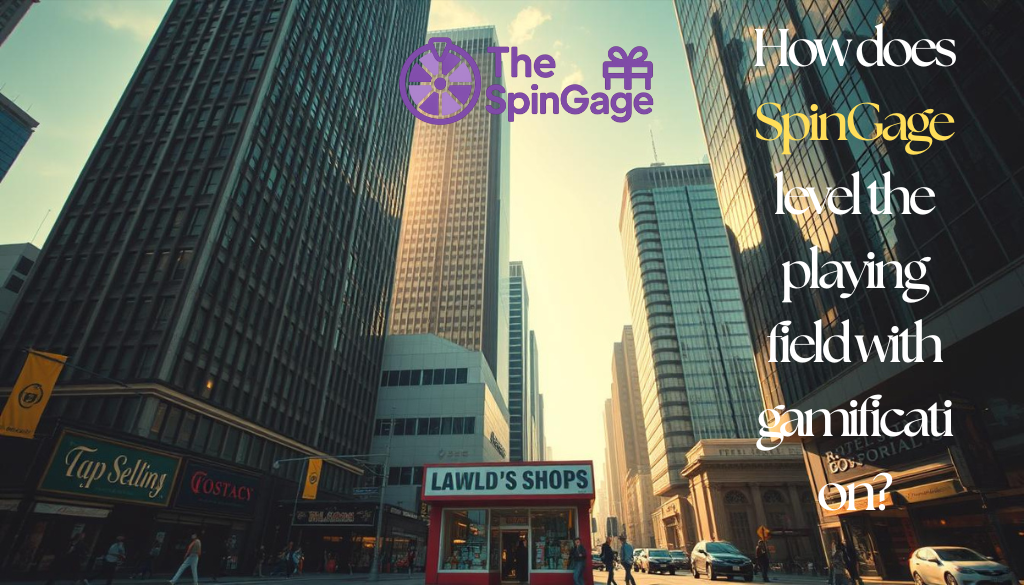
SpinGage levels the playing field with gamification by transforming ordinary tasks into engaging, interactive experiences that motivate participants regardless of their starting skill level. Through its game-like elements—such as point systems, leaderboards, challenges, and rewards—SpinGage encourages users to actively participate and improve over time. This approach creates a sense of accomplishment and competition that is accessible to everyone, not just those with prior expertise or resources. By making progress measurable and visible, SpinGage fosters an environment where effort and consistency are recognized, allowing smaller businesses, individual users, or newcomers to compete on more equal footing with larger, more established players. Ultimately, gamification removes traditional barriers and turns skill-building, learning, and performance into a motivating and inclusive experience.
How does SpinGage automate review collection?
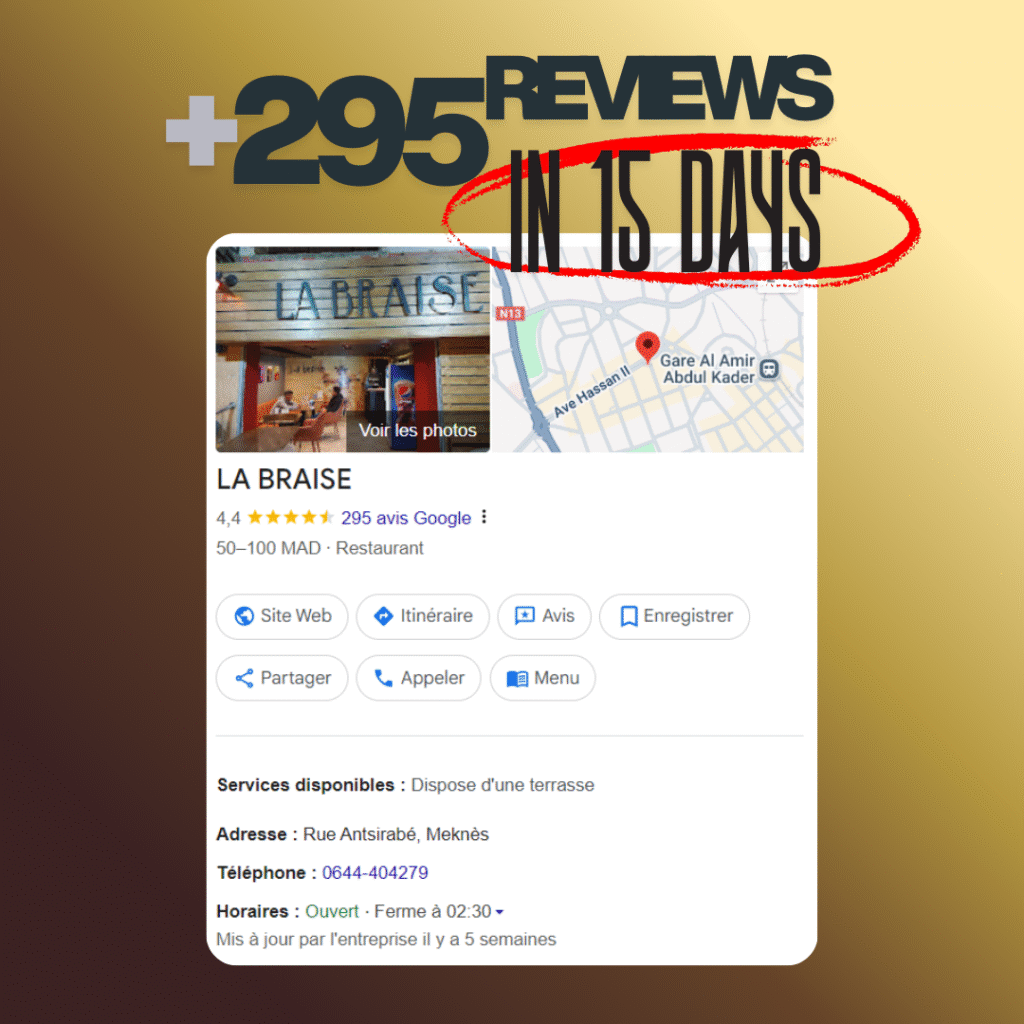
+295 REVIEWS IN JUST 15 DAYS :
Labraise is a restaurant that gained more than 295 new customer reviews and increased their income by using TheSpinGage solution.
They placed a flyer with a QR code on every table, allowing each diner to scan and spin the wheel. Labraise used a 100% winning ratio plan, where customers always won either 10% off their meal or a free soda.
This simple gamification encouraged guests to leave reviews, boosted loyalty, and kept customers coming back.
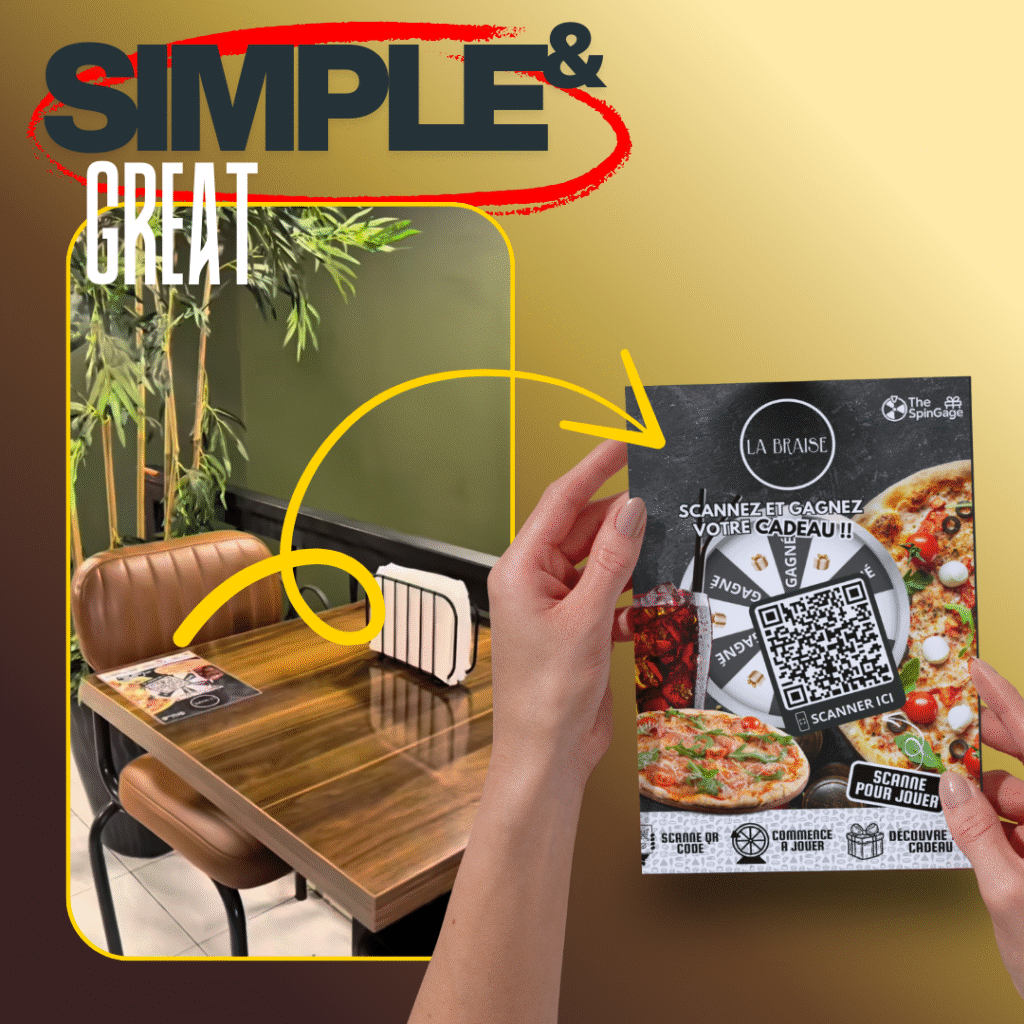
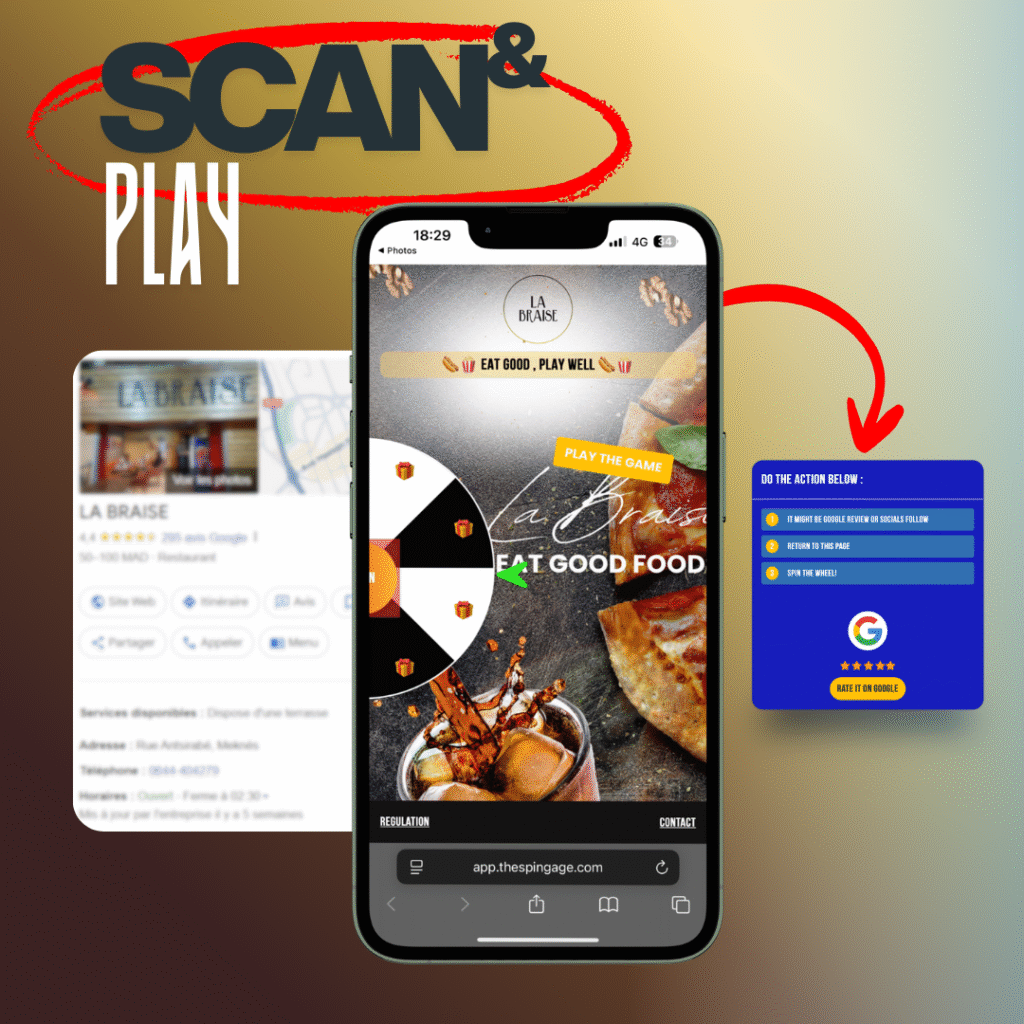
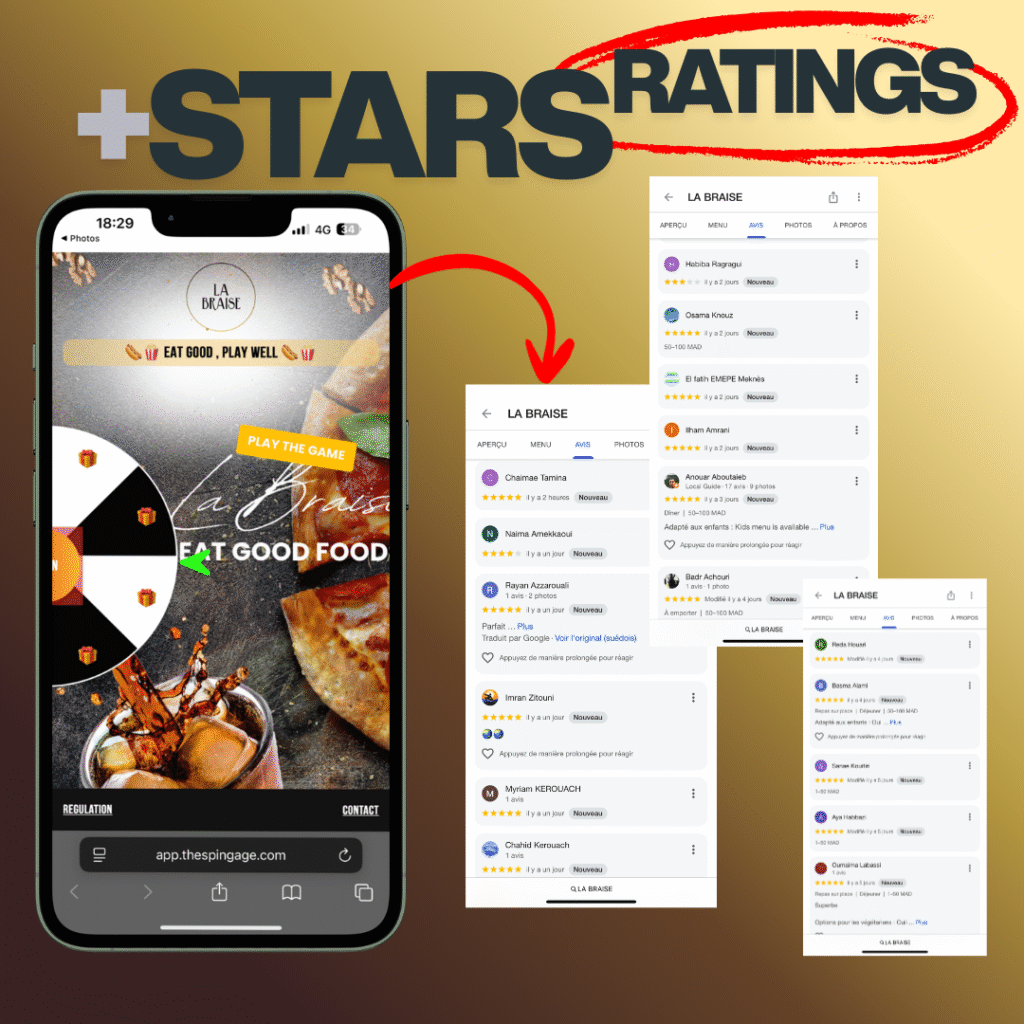
HOW IT WORKS IN 4 EASY STEPS ?
1 – Scan the QR Code
Clients simply scan the QR code placed on the table or provided directly by you.
2- Take Action First
To unlock the gameplay, they must complete the required action.
3- Spin the Wheel
Once unlocked, they spin the wheel to test their luck.
4- Win Rewards
If they win, a QR code is instantly sent to their email. If not, nothing happens. In both cases, the game is locked for 24 hours, ensuring fairness and excitement for the next try.
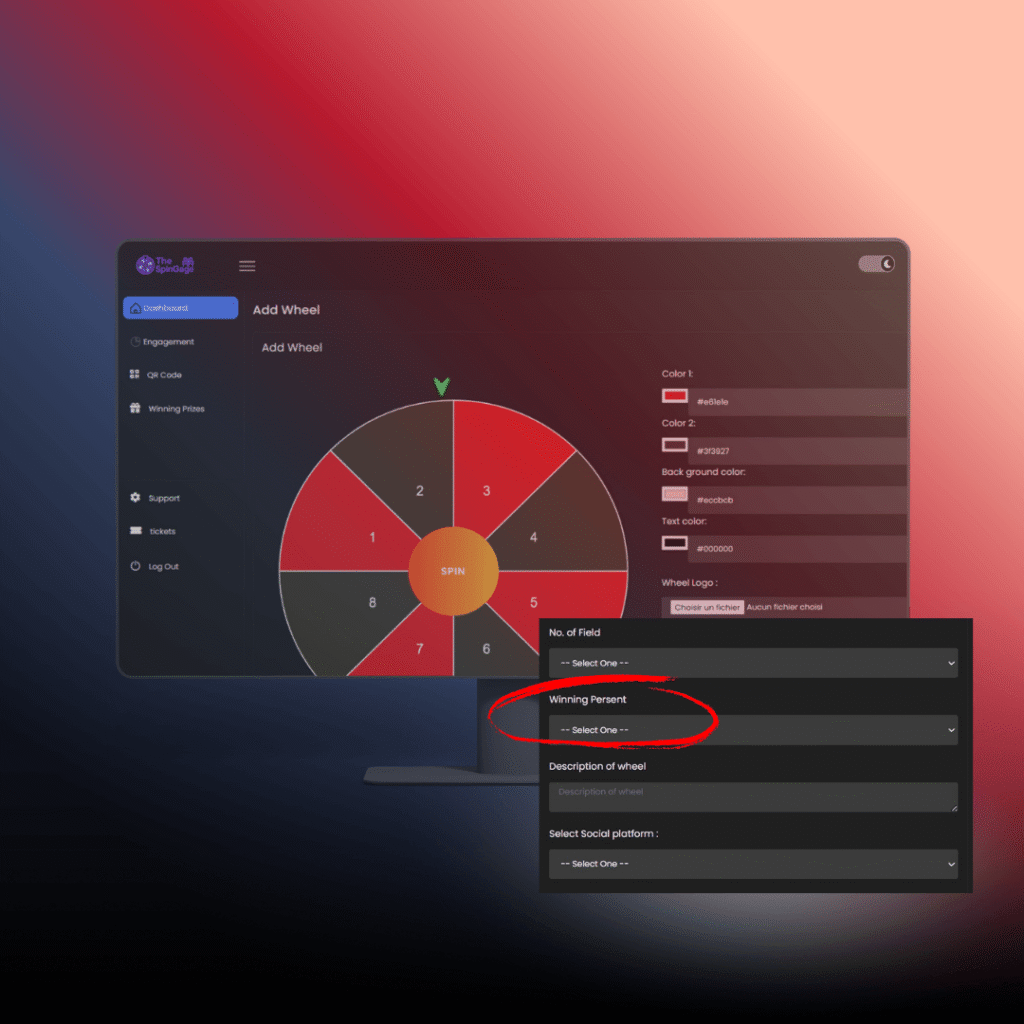
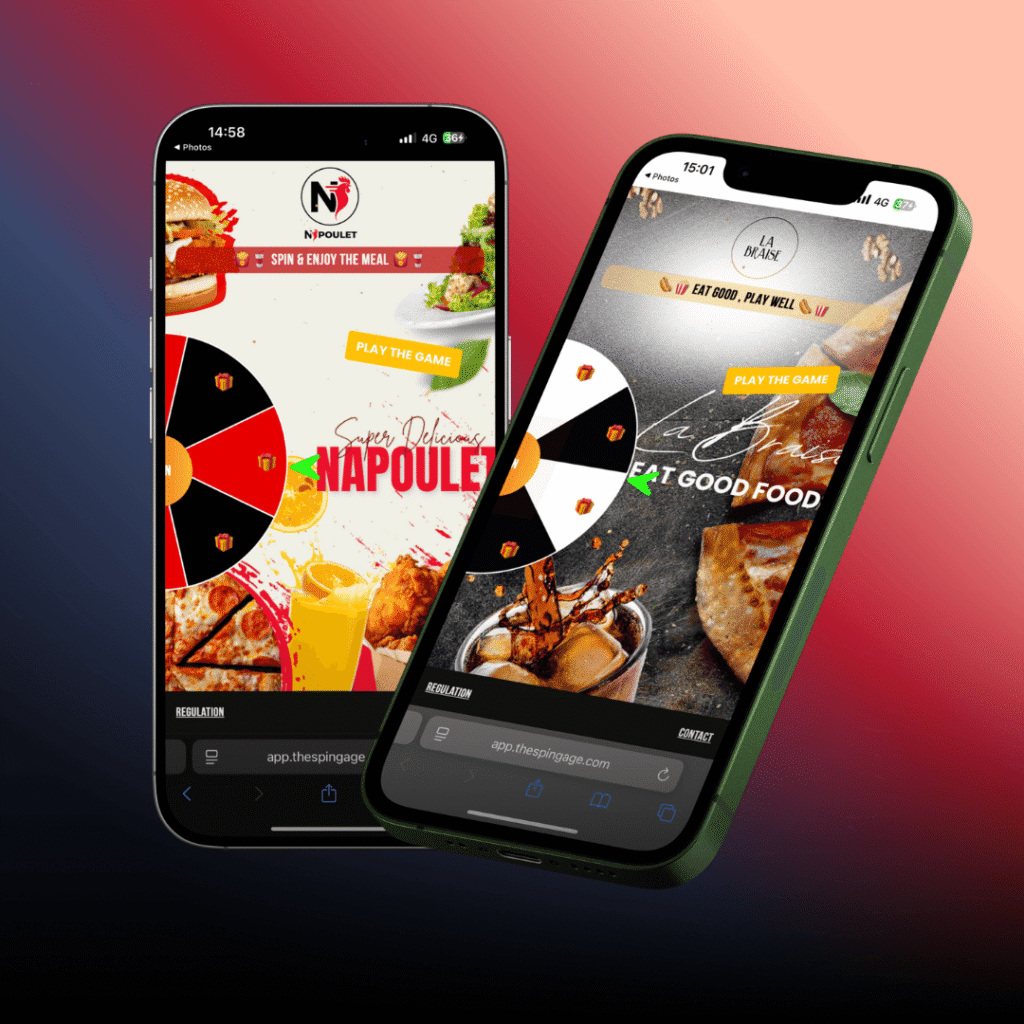
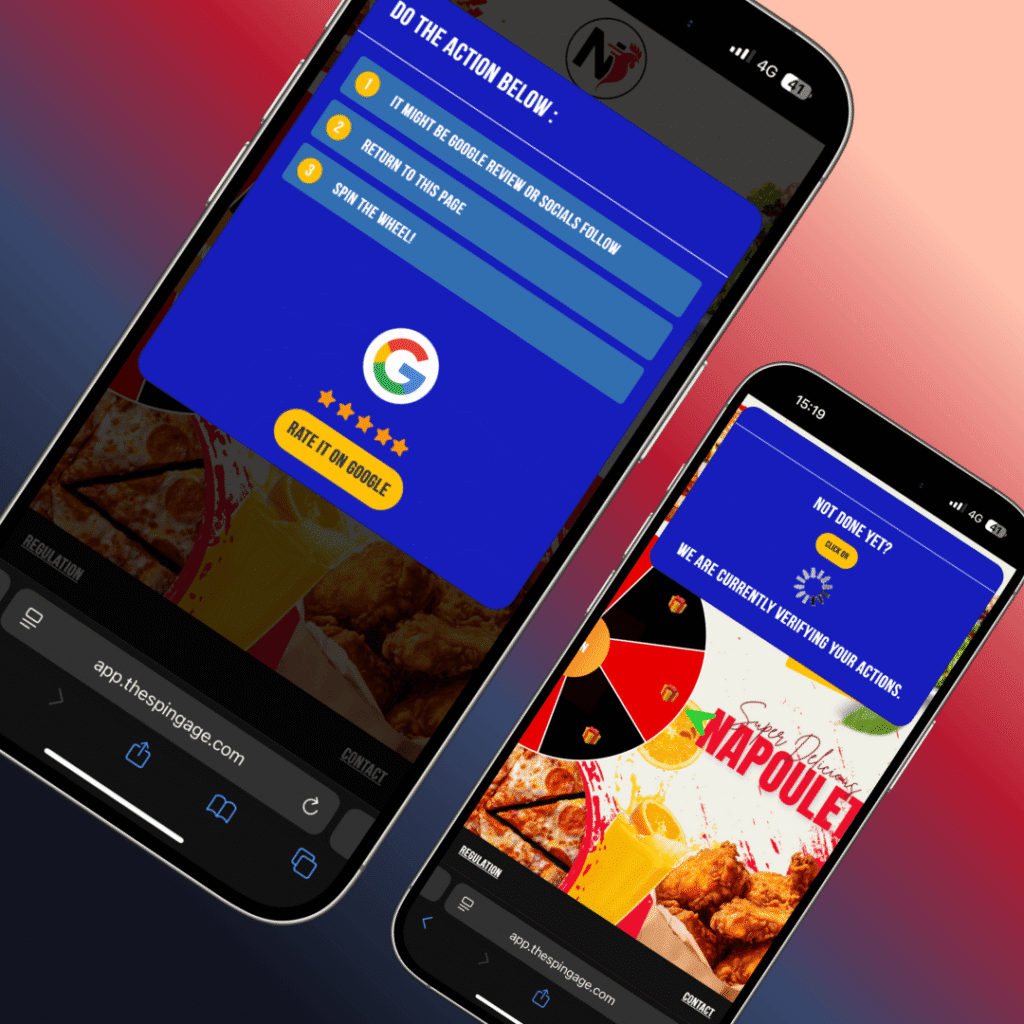
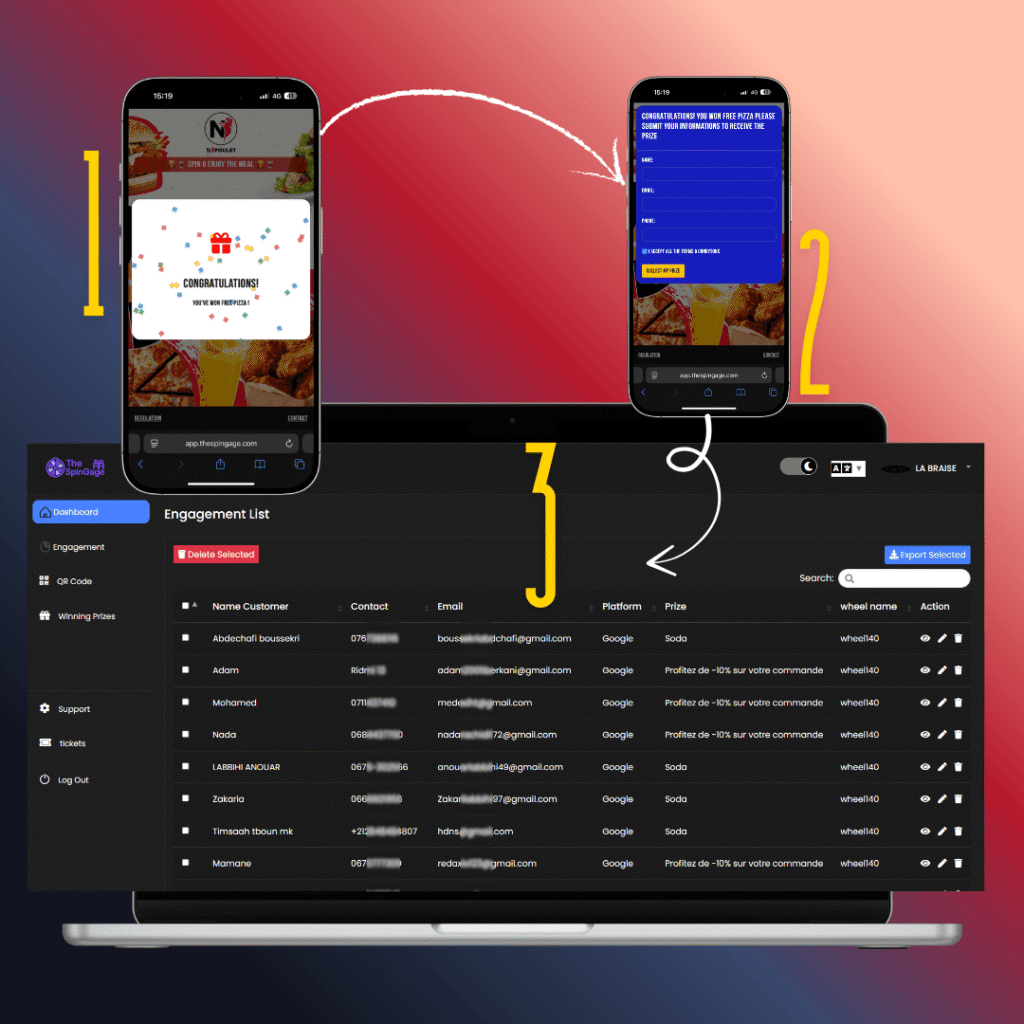
🛠️ Flexible Tracking Options
Track platform Top performing .
Track the wheel segments (number of prizes, Winner Gameplay).
Number of Plays , Track top performing wheel
Set up expiration dates for vouchers and offers.
Get Acces to LEADS , Extraxt & Modiify it .
Why You Should Opt for TheSpinGage Solution
Running a business today is not just about serving customers – it’s about creating memorable experiences that keep them coming back and spreading the word. That’s exactly what TheSpinGage delivers.
🎯 Stand Out from Your Competitors
Most restaurants, cafés, and shops rely only on discounts or word of mouth. With TheSpinGage, you turn every visit into a fun, interactive moment that clients remember and talk about.
⭐ Collect More Positive Reviews
Google reviews are the new “digital reputation.” Our system motivates clients to leave reviews in exchange for a chance to win rewards – giving you the social proof that attracts new clients effortlessly.
💌 Grow Your Customer Database
Every spin is an opportunity to collect emails and data, helping you stay connected with your clients through newsletters, promotions, and loyalty campaigns.
🔄 Boost Loyalty and Repeat Visits
Customers love rewards. By making every visit a chance to win, you encourage repeat visits, turning occasional clients into loyal fans of your business.
⚡ 100% Simple & Automated
No technical headaches. Once installed, TheSpinGage works automatically – whether through QR codes on tables, flyers, or digital screens. You just set the rules, and the system does the rest.
👉 TheSpinGage isn’t just a tool – it’s your new customer magnet.
Increase engagement, grow your reviews, and build a strong database without spending more on ads.
📲 Activate TheSpinGage today and turn visitors into loyal, returning customers!
START TODAY


SpinGage automates review collection by seamlessly integrating with your business platforms to prompt customers for feedback at the right moment. It can automatically send personalized review requests via email or SMS after a purchase or service, making it easy for customers to share their experiences. This automation not only increases the volume of reviews but also ensures consistent and timely feedback, helping businesses maintain a strong online reputation without manual effort.
Combine this with strategic local SEO practices, including keyword research, category optimization, and building citations and backlinks, and you’re positioning your business to dominate local se
Take the first step today to elevate your small business and stand out in your local market!
Discover Winning Strategies Here →
The David vs. Goliath Business Landscape
In today’s competitive business landscape, small businesses are often seen as underdogs against big brands. However, this perception overlooks the unique strengths that small local businesses bring to the table.
Understanding the Modern Competitive Environment
The modern competitive environment is characterized by rapid technological advancements and shifting consumer behaviors. Big brands have significant resources to adapt to these changes, but they often struggle with agility and personalization.
Small businesses, on the other hand, can quickly pivot to meet new market demands. This agility allows them to capitalize on opportunities that larger corporations might miss.
Why Small Businesses Can Thrive Alongside Giants
Despite the advantages held by big brands, small businesses can thrive due to their ability to form personalized customer relationships and leverage local knowledge. These strengths enable small businesses to carve out their own niche in the market.
| Competitive Factor | Big Brands | Small Local Businesses |
|---|---|---|
| Agility | Limited by bureaucracy | Quick decision-making |
| Customer Relationships | Often impersonal | Personalized and community-focused |
| Market Knowledge | Broad, but sometimes lacking local insight | Deep understanding of local market nuances |
By understanding these competitive dynamics, small local businesses can effectively compete with larger brands, leveraging their unique advantages to thrive in a competitive market.
Leveraging Your Small Business Advantages
As a small local business, you have unique advantages that can help you compete with bigger brands. These strengths allow you to be more responsive to customer needs and adapt quickly to changes in the market.
Agility and Quick Decision-Making
One of the significant small business advantages is agility in business, enabling you to make decisions rapidly and implement changes without the bureaucratic red tape that often slows down larger corporations. This agility allows you to respond promptly to customer feedback, capitalize on new opportunities, and stay ahead of the competition.
Personalized Customer Relationships
Small local businesses excel at providing personalized customer service. By building strong, personal relationships with your customers, you can create a loyal customer base that appreciates the tailored service you provide. This personal touch is often lacking in larger businesses, giving you a competitive edge.
Local Knowledge and Community Connections
Your business’s local knowledge and connections within the community are invaluable assets. Understanding the local culture, needs, and preferences allows you to tailor your products or services to meet the specific demands of your area. This localized approach can make your business more relevant and appealing to local customers.
By leveraging these advantages, small local businesses can effectively compete with larger brands and establish a strong presence in their community.
Developing a Unique Value Proposition
To compete effectively, small local businesses need to identify and communicate their unique strengths. A unique value proposition (UVP) is a statement that clearly communicates the unique benefits that your business offers to customers.
Identifying Your Competitive Edge
Your competitive edge is what sets your business apart from larger competitors. It could be anything from personalized customer service to specialized products or local knowledge.
- Analyze customer feedback to understand what they value most.
- Assess your business operations to identify areas of excellence.
- Research competitors to find gaps in their offerings.
Communicating What Makes You Special
Once you’ve identified your competitive edge, it’s crucial to communicate this effectively to your target audience. Use clear, concise language in your marketing materials and ensure that your UVP is consistently presented across all channels.
Key elements to communicate:
- The unique benefits you offer.
- How your business solves customers’ problems.
- What makes your business more appealing than larger competitors.
Positioning Against Big Brand Weaknesses
Big brands often have weaknesses that small businesses can exploit. For example, larger companies may have slower response times or less personalized service.
| Big Brand Weaknesses | Small Business Opportunities |
|---|---|
| Slow customer service | Quick, personalized responses |
| Lack of local knowledge | Deep understanding of local needs and preferences |
| Standardized products/services | Customized solutions tailored to individual customers |
Local Marketing Strategies to Compete with Big Brands as a Small Local Business
Small local businesses can effectively compete with larger brands by leveraging local marketing strategies. These strategies are designed to highlight the unique strengths of small businesses and their connection to the local community.
Hyperlocal SEO Techniques
Hyperlocal SEO is crucial for small businesses to attract local customers. This involves optimizing your website for location-based searches and creating content that is relevant to your local audience.
Key Hyperlocal SEO Strategies:
- Optimize your Google My Business listing
- Use location-specific keywords on your website
- Create content about local events or news
Community Event Sponsorships
Sponsoring local events is a powerful way to increase your business’s visibility and demonstrate your commitment to the community.
“Community event sponsorships not only boost brand awareness but also foster goodwill among local residents.”
Local Media Partnerships
Partnering with local media outlets can help you reach a wider audience. This can include collaborations with local newspapers, radio stations, or influencers.
Benefits of Local Media Partnerships:
| Benefit | Description |
|---|---|
| Increased Reach | Access to a broader local audience |
| Credibility | Association with reputable local media |
Neighborhood Loyalty Programs
Implementing loyalty programs that reward local customers can help retain existing customers and attract new ones.
Example of a Neighborhood Loyalty Program:
- Offer discounts to local residents
- Create a points system for purchases
- Host exclusive events for loyalty program members

Building a Distinctive Brand Identity
A well-crafted brand identity can be the differentiator that sets small local businesses apart from big brands. It’s not just about having a logo or a color scheme; it’s about creating an emotional connection with your customers.
To achieve this, small businesses can focus on authentic storytelling that resonates with the local community. Sharing the story behind your business, highlighting local ingredients or craftsmanship, and showcasing your commitment to the community can foster a deep sense of loyalty among customers.
Authentic Storytelling That Resonates Locally
Authentic storytelling involves sharing your business’s history, values, and mission in a way that connects with local customers. For instance, a local bakery might share stories about family recipes passed down through generations, or a boutique might highlight its commitment to sourcing products from local artisans.

Visual Branding That Stands Out
Visual branding is another critical aspect of building a distinctive brand identity. This includes your logo, color palette, typography, and overall visual aesthetic. A unique and consistent visual brand helps customers recognize and remember your business.
As branding expert Marty Neumeier once said,
“A brand is a person’s gut feeling about a product, service, or company.”
Your visual branding should evoke the right gut feeling, making customers trust and prefer your brand over others.
Consistent Messaging Across All Touchpoints
Consistent messaging is crucial to reinforcing your brand identity across all customer touchpoints, from your website and social media to in-store experiences and customer service. Consistency helps build trust and reinforces your brand’s values and mission.
By maintaining a consistent tone, language, and visual elements across all platforms, small local businesses can create a cohesive brand image that resonates with their target audience.
Delivering Superior Customer Experiences
The key to thriving as a small local business lies in creating memorable customer experiences that foster long-term loyalty. By focusing on the aspects that make personal interactions meaningful, small businesses can differentiate themselves significantly from larger competitors.
Personalized Service Approaches
Personalized service is about understanding and meeting the individual needs of customers. Training staff to recognize and remember regular customers can make a significant difference. Simple gestures, such as addressing customers by name or knowing their preferences, can create a warm and welcoming atmosphere.
Creating Memorable In-Store Experiences
The physical store environment plays a crucial role in shaping customer experiences. Creating an inviting store layout and ensuring that the shopping environment is clean and comfortable are essential. Additionally, hosting in-store events or workshops can enhance the shopping experience, making it more engaging and memorable.

Building Long-Term Customer Relationships
Building long-term relationships with customers involves consistent engagement and showing appreciation for their loyalty. Implementing loyalty programs that reward repeat customers is an effective strategy. Regular communication through newsletters or personalized emails can also help maintain a strong connection with customers.
Handling Customer Feedback Effectively
Customer feedback is invaluable for improving services and experiences. Actively seeking and responding to customer feedback demonstrates a commitment to customer satisfaction. It’s essential to address concerns promptly and make visible changes based on customer suggestions to show that their input is valued.
| Strategy | Benefits | Implementation Tips |
|---|---|---|
| Personalized Service | Increased customer loyalty, positive word-of-mouth | Train staff to recognize regular customers, use customer data to personalize interactions |
| In-Store Events | Enhanced customer engagement, increased foot traffic | Host workshops, product launches, or themed events that appeal to your customer base |
| Loyalty Programs | Repeat business, customer retention | Design programs that reward purchases or referrals, communicate benefits clearly to customers |
Digital Marketing Tactics for Small Business Success
Digital marketing has leveled the playing field for small local businesses, offering a range of tools to compete with bigger companies. By leveraging the right digital marketing tactics, small businesses can reach their target audience more effectively and drive growth.
Social Media Strategies That Outperform Big Brands
Small local businesses can outperform big brands on social media by being more agile and responsive to their local audience. Engaging content that resonates with the local community can help build a loyal following. For instance, sharing behind-the-scenes moments or highlighting local events can make your business more relatable.
Email Marketing That Drives Loyalty
Email marketing remains a powerful tool for small businesses to build customer loyalty. By creating personalized email campaigns that cater to the specific needs and interests of their customers, businesses can foster a strong connection with their audience.
Content Marketing to Establish Authority
Content marketing is crucial for establishing a small business as an authority in its niche. By creating valuable and relevant content, businesses can attract and retain customers.
Creating Local-Focused Content
Creating content that is focused on local issues, events, or news can help a small business appear more relevant and connected to its community. This can include blog posts about local happenings or social media updates about community involvement.
Showcasing Your Expertise
Showcasing expertise through content marketing can be achieved by sharing knowledge and insights related to your business niche. This can be done through blog posts, videos, or social media content that provides value to your audience.
| Digital Marketing Tactic | Description | Benefit |
|---|---|---|
| Social Media | Engage with local audience | Increased brand awareness |
| Email Marketing | Personalized campaigns | Customer loyalty |
| Content Marketing | Valuable and relevant content | Established authority |
Forming Strategic Partnerships and Collaborations
Small local businesses can significantly boost their market presence by forming strategic partnerships. By collaborating with other businesses, they can leverage each other’s strengths to achieve common goals.
Partnering with Complementary Local Businesses
One effective way to form strategic partnerships is by collaborating with businesses that offer complementary products or services. For example, a coffee shop might partner with a local bakery to offer a bundled deal, enhancing the customer experience and increasing sales for both businesses.
Creating Cooperative Marketing Initiatives
Cooperative marketing initiatives allow businesses to pool their resources and reach a wider audience. This can include joint social media campaigns, co-branded events, or collaborative content creation. By working together, businesses can reduce marketing costs and amplify their message.
Leveraging Shared Resources
Strategic partnerships can also enable businesses to share resources, such as technology, expertise, or infrastructure. This can lead to cost savings and improved operational efficiency. For instance, two businesses might share a delivery service or co-locate to reduce overhead costs.
| Benefits | Description | Example |
|---|---|---|
| Increased Market Presence | Reach new customers through partnerships | Co-branded marketing campaign |
| Enhanced Customer Experience | Offer bundled or complementary products/services | Coffee shop and bakery partnership |
| Cost Savings | Share resources and reduce operational costs | Shared delivery service |
By forming strategic partnerships, small local businesses can create a competitive edge, improve their market position, and achieve sustainable growth.
Optimizing Operations for Competitive Advantage
Small local businesses can gain a competitive edge by streamlining their operations and leveraging technology. In today’s fast-paced business environment, operational efficiency is crucial for staying ahead of the competition.
Streamlining Processes Without Sacrificing Quality
To optimize operations, small businesses should focus on streamlining processes without compromising on quality. This can be achieved by:
- Identifying and eliminating redundant tasks
- Implementing efficient workflows
- Training staff to multitask and adapt to new processes
By simplifying operations, businesses can reduce costs and improve productivity.
Smart Inventory Management
Effective inventory management is vital for maintaining a competitive edge. Small businesses can benefit from:
- Implementing just-in-time inventory systems
- Using inventory management software to track stock levels
- Analyzing sales data to predict demand
By optimizing inventory, businesses can minimize waste and ensure that products are available when customers need them.
Technology Solutions for Small Business Efficiency
Leveraging technology solutions can significantly enhance operational efficiency. Small businesses can benefit from:
- Cloud-based accounting and management software
- Automated customer relationship management (CRM) systems
- Digital payment processing systems
By embracing technology, small businesses can streamline operations, improve customer service, and gain a competitive advantage.
Measuring Success and Adapting Strategies
To stay competitive, small businesses must continually assess their performance and adjust their strategies. This ongoing process involves identifying key performance indicators (KPIs) that matter most to their business.
Key Performance Indicators for Small Businesses
KPIs help small businesses measure their success in various areas. Common KPIs include customer acquisition costs, customer retention rates, and sales growth. For instance, a local coffee shop might track the number of loyalty program sign-ups as a KPI for customer retention.
| KPI | Description | Example |
|---|---|---|
| Customer Acquisition Cost | The cost of acquiring a new customer | $10 spent on social media ads |
| Customer Retention Rate | Percentage of customers retained over time | 75% of customers return within a month |
| Sales Growth | Increase in sales over a specific period | 15% increase in monthly sales |
Tools for Tracking Competitive Performance
Several tools can help small businesses track their competitive performance. These include Google Analytics for website traffic analysis, social media insights for engagement metrics, and competitor analysis software.
As Forbes notes, “Using the right tools to measure performance can significantly impact a small business’s ability to compete.”
“The key is not to prioritize what’s on your calendar, but to schedule your priorities.” – Stephen Covey
When and How to Pivot Your Approach
Pivoting involves changing your business strategy based on performance data. For example, if a small business finds that its social media engagement is low, it might pivot by changing its content strategy or focusing on different platforms.
By regularly measuring success and adapting strategies, small businesses can stay competitive and achieve their goals.
Conclusion
Competing with big brands as a small local business requires a strategic approach. By leveraging your unique strengths, such as agility and personalized customer relationships, you can carve out a niche in the market.
Effective small local business success strategies include developing a strong brand identity, delivering superior customer experiences, and utilizing digital marketing tactics. By forming strategic partnerships and optimizing operations, small businesses can further enhance their competitive edge.
Ultimately, thriving in the local market is about understanding your customers’ needs and adapting to the ever-changing business landscape. By implementing the strategies outlined in this article, small local businesses can successfully compete with big brands and establish a loyal customer base.
FAQ
What are the main challenges small local businesses face when competing with larger brands?
Small local businesses often struggle to compete with larger brands due to limited resources, brand recognition, and marketing budgets. However, they can leverage their unique strengths, such as agility, personalized customer service, and local knowledge, to attract and retain customers.
How can small businesses develop a unique value proposition to stand out from bigger competitors?
To develop a unique value proposition, small businesses should identify their competitive edge, communicate their unique strengths, and position themselves against the weaknesses of bigger brands. This can be achieved by focusing on their agility, personalized customer service, and local knowledge.
What are some effective local marketing strategies for small businesses to compete with big brands?
Effective local marketing strategies for small businesses include hyperlocal SEO techniques, community event sponsorships, local media partnerships, and neighborhood loyalty programs. These strategies can help small businesses attract and retain local customers.
How can small businesses build a distinctive brand identity to stand out from larger competitors?
Small businesses can build a distinctive brand identity by focusing on authentic storytelling, visual branding, and consistent messaging across all customer touchpoints. This can help create a strong brand image that resonates with local customers.
What are some digital marketing tactics that can help small local businesses succeed?
Digital marketing tactics that can help small local businesses succeed include social media strategies, email marketing, and content marketing. Small businesses can create local-focused content, showcase their expertise, and leverage social media to attract and retain customers.
How can small businesses measure their success and adapt their strategies accordingly?
Small businesses can measure their success by tracking key performance indicators, such as sales, customer retention, and website traffic. They can also use tools to track competitive performance and adjust their strategies accordingly.
What are some benefits of forming strategic partnerships and collaborations for small local businesses?
Forming strategic partnerships and collaborations can help small local businesses leverage shared resources, create cooperative marketing initiatives, and partner with complementary businesses. This can help them attract new customers, improve their offerings, and stay competitive.
How can small businesses optimize their operations to gain a competitive advantage?
Small businesses can optimize their operations by streamlining processes, implementing smart inventory management, and leveraging technology solutions to enhance efficiency. This can help them reduce costs, improve customer satisfaction, and stay competitive.
What are some key performance indicators that small businesses should track?
Key performance indicators that small businesses should track include sales, customer retention, website traffic, and social media engagement. These metrics can help small businesses measure their success and adjust their strategies accordingly.



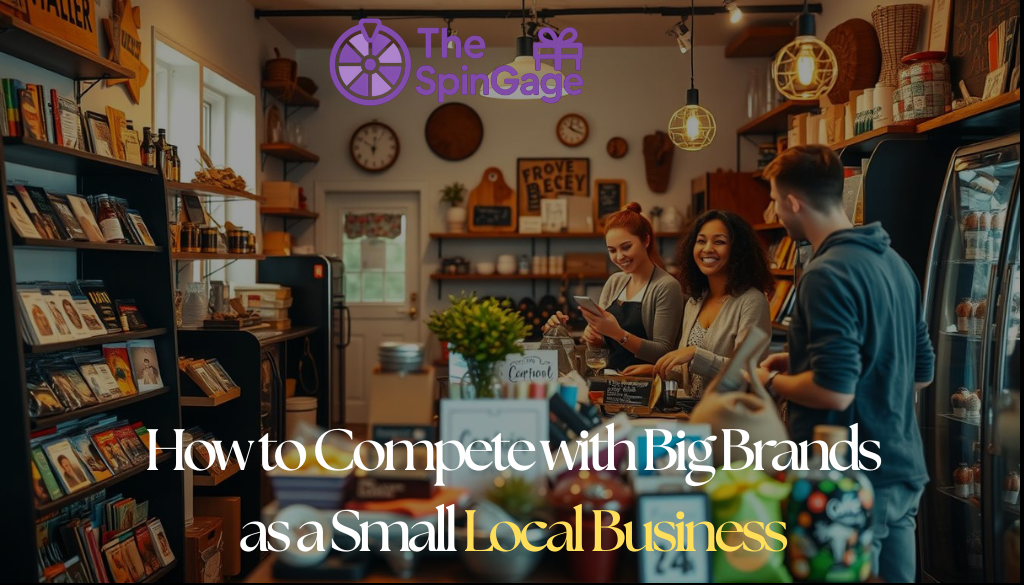


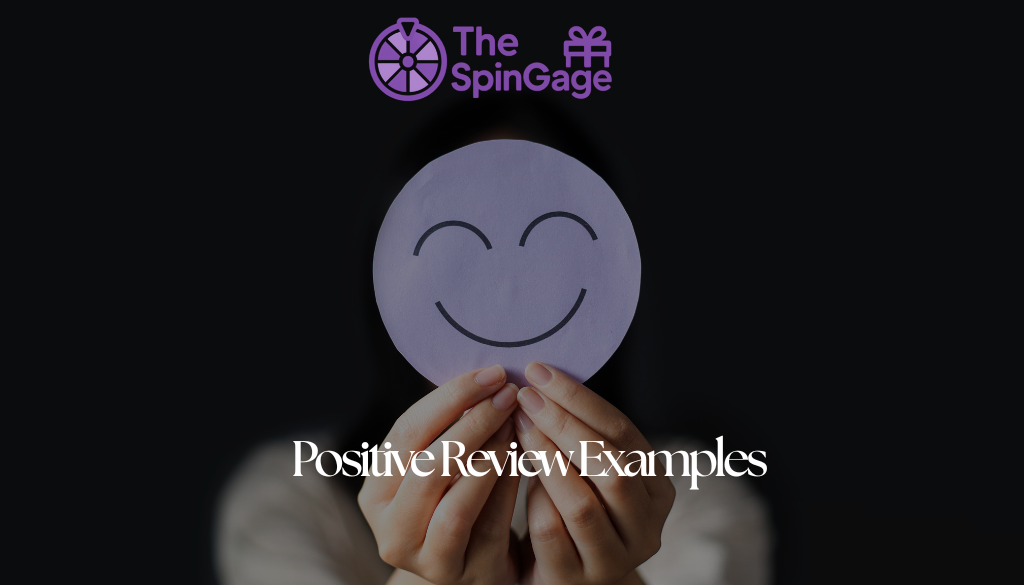
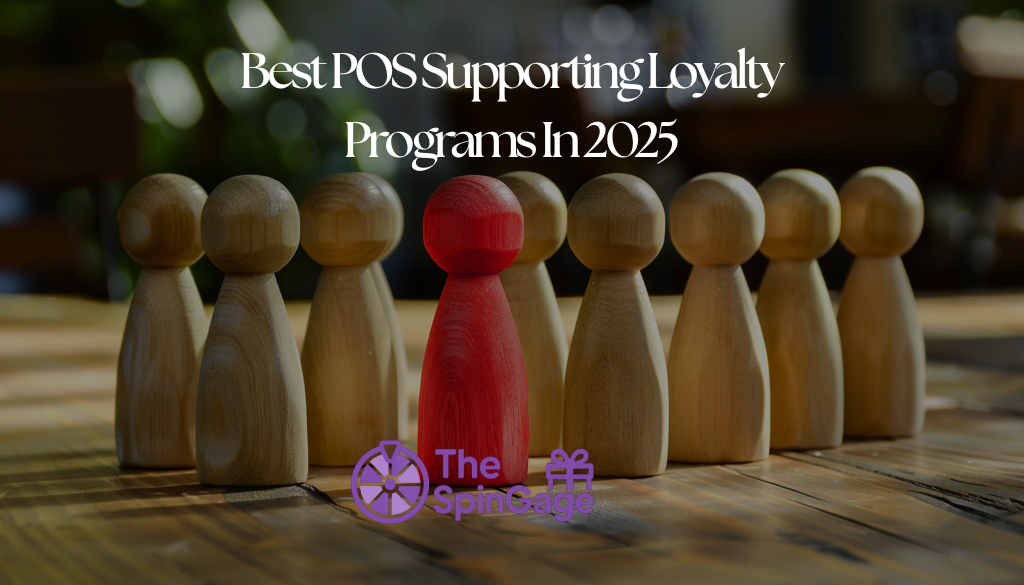
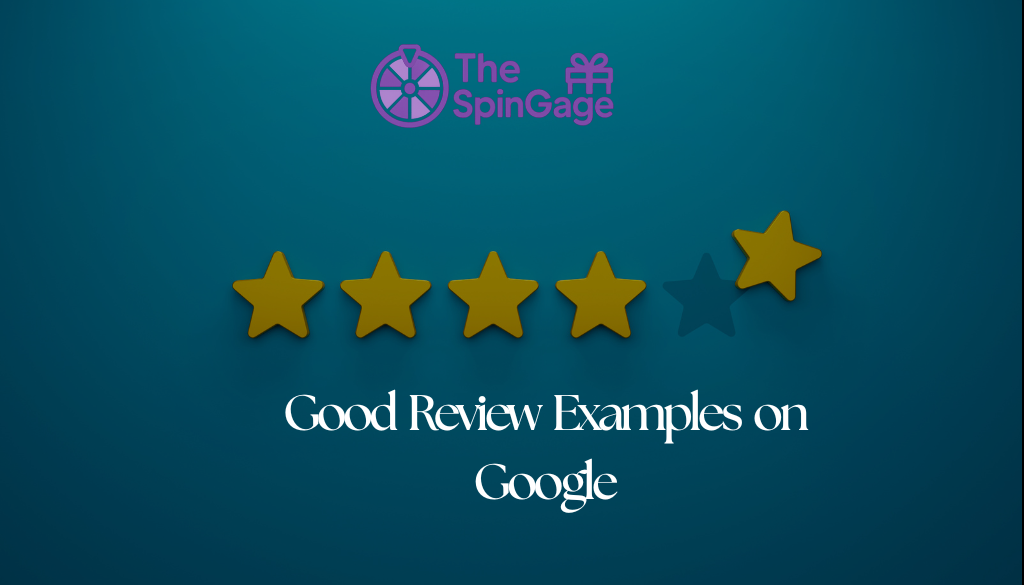



Leave a Reply